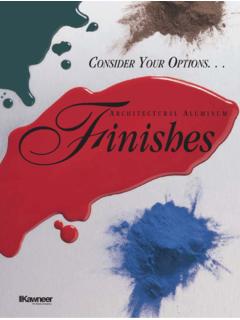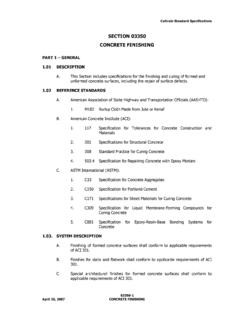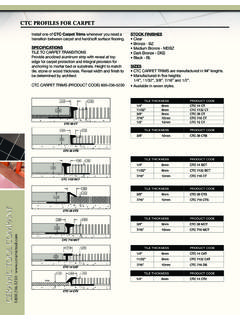Transcription of To avoid damage to the glazed face keep the units in the ...
1 Product Information SheetStructural glazed tileSection 4 MasonryMethod: To avoid damage to the glazed face keep the units in the manufacturers packaging until the individual unit is ready to be laid in the wall. Do not wet units . The mason should apply mortar to each brick with full head and bed joints shoving unit into place keeping plumb, square and level to the line. Joints should be uniform 3/8 , except for 6T Series, which is 5/16 . Tool joints concave with 1 or larger non-metallic jointer. Cut SGT using a wet masonry saw, diamond blade. Keep excess mortar from the face of the brick by wiping with a clean rag within 30 minutes. Do not use metal tools on glazed face. Allow wall to cure for 24 hours. Clean finished walls by wetting with clean water then applying detergent, if necessary, and scrubbing with a stiff fiber brush. Use a wooden scraper to remove excess mortar from difficult areas. Rinse thoroughly with clean water. Do not use acids or abrasive cleaners. Protect finished walls from damage caused by other trades and most exterior applications: Do not wet units .
2 Lay units with cells running vertically to allow for drainage of moisture within the wall; cavity wall construction consisting of a minimum 2 cavity, appropriate flashing and weep holes and vents following the guidelines as outlined by the Brick Industry Association, is necessary; proper coping, sloped sills and attention to areas where projections or recesses exist, detail to permit drainage to flashing then weep holes. Do not use joint sealers on exterior. 6. MaiNteNaNceOccasional cleaning can be done with soap and water in areas as needed. Power sprayers may be used, however, take care not to damage the mortar joints. For graffiti use paint thinner or a detergent product to remove the paint/marker etc. Always be careful not to etch or yellow the mortar joints. Contact the manufacturer for cleaning product aVailaBilitY aNd cOStAvailability: Available through distributors in the United States and Canada; for exporting to other countries contact the manufacturer. Allow sufficient time for manufacturing and shipping.
3 The finished product normally takes 8 to 10 weeks (depending on demand, any special shapes and/or custom color development, additional time may be required). Cost: The cost averages will vary depending on the amount of shapes and colors used, shipping distance and local labor costs. Visit cost information on our website from Means Building Construction Cost WarraNtYElgin Butler Company will certify that its products meet the standards set forth by ASTM C-126 for quality, product durability, tolerances, and grading specifications. For any suspected non-conforming material found prior to its installation contact the manufacturer to arrange for inspection and determination. 9. tecHNical SerViceSTechnical assistance is available by calling our manufacturing facility at (512) 285-3356 or by calling directly to the technical service manager at (330) 877-6654. Assistance is also available through our network of qualified distributors throughout the and Canada. EBC01/07 KgBuilding Codes: Structural glazed Tile is found acceptable in most major building codes.
4 SGT is also USDA and FDA approved. Compressive Strength: SGT is a structural clay masonry unit that can be used in loadbearing and non-loadbearing applications. Minimum compressive strengths listed below: These SGT units generally far exceed the minimum compressive strength requirements as Net and Gross Area. Compressive Strength, psi (MPa), gross areaDirection of Coring Minimum Avg. of Test units Individual Minimum Per Unit Vertical 3,000 ( ) 2,500 ( )Horizontal 2,000 ( ) 1,500 ( )Properties of Finish as Follows: Listed are minimum standards for the ceramic glazed finish substantiating durability, building safety and lifetime low maintenance. Test criteria and details for each located in ASTM C-126. Special decorative, double-fired and clear ceramic glazes are exempt. Imperviousness: Subject the finish to a permanent blue-black ink test for 5 minutes then washing with a wet cloth and running water. No stain visible from 5 feet except a slight discoloration in the depressions on matte, stippled or mottled glazes and in crevices formed by units body texture.
5 Opacity: Discoloration from the body should not be visible through the glaze, when so specified. Consult manufacturer on clear or custom glazes. Resistance to Fading: The color of the glaze will not change when subjected to chemical resistance tests. Chemical Resistance: The color and texture of the glaze will not change when subjected to the hydrochloric and potassium hydroxide chemical resistance tests. Resistance to Crazing: The glaze will not craze, spall or crack when subjected to one cycle of autoclaving in the crazing test. Flame Spread, Fuel Contribution and Smoke Density: Rated zero in all categories when tested in accordance with ASTM E-84 (equivalent UL 723). No toxic fumes. Fire Resistance: SGT is tested in accordance with ASTM E-119 (equivalent test UL 263) for fire resistance ratings. Fire ratings of various wall assemblages vary according to wall thickness and the SGT units used (percentage of solid and number and direction of cells). Industry standards tested and currently used can be found in the manufacturers technical literature.
6 See specific wall detail. Some special fire-rated SGT units are also available typically giving a higher rating that a standard unit of the same size. Hardness and Abrasion Resistance: Ceramic glaze must resist scratching by steel or ordinary glass and be rated above 5 on the Mohs Hardness Scale. Abrasion tested under Wear Index Method No. 6192 (Federal Standard Test No. 141). iNStallatiONPreparation: In preparation for the proper installation of SGT the mason contractor should be familiar with the recommendations and requirements of the Brick Industry Association and the manufacturer. The material should be kept clean and dry. Do not lay SGT units in extreme cold or hot weather conditions without taking necessary precautions for such conditions to ensure proper bonding. mortars : Structural glazed Tile is laid in standard cement mortar following the guidelines in ASTM C-270, Mortar for Unit Masonry. Generally Type N or S mortar will provide the satisfactory properties desired.
7 Type M mortar may be required when high compressive strength control PrOductStructural glazed Tile2. MaNuFacturerElgin Butler Company 365 FM 696 | Elgin, TX 78621-5034 | p (512) 285-3356 | f (512) 281-2487 deScriPtiONUnit Description: Structural glazed Tile is extruded clay, ceramic glazed masonry units for loadbearing and non-loadbearing wall applications. Used as structural walls, partition walls, multi-wythe-walls, or veneers. The ceramic finish is available in many colors. Offering a durable permanent wall system that has an impervious ceramic glazed face with a high abuse tolerance against graffiti, impact and abrasion. Sizes*:^ASTM C 1405 *Common sizes listed. Other sizes available, contact : Standard stretchers, starters, jambs, sills, lintels, internal and external corners, miters; base units as straight, recessed and non-recessed cove base and Quik Base (4 x 16 ). Bullnose or square edges. Architectural Trim units and special shapes available. Finishes and Colors: Standard, non-standard and custom colors available from Elgin Butler s library of colors.
8 Gloss, satin, matte, mottled, and ultra matte glazes. Contact manufacturer for samples in color scheme desired. Request production run samples for final color approval. Grades: ASTM C-126a. Grade S (Select) for use with comparatively narrow mortar joints. Standard dimensional and distortion tolerances. b. ASTM C-126 modified, Elgin Butler s MCS Grade, Modular Ceramic System, economical but aesthetically pleasing including small chips, cracks, pinholes, or other minor glaze imperfections. Structurally sound. c. ASTM C-126, Grade SS (Select Sized), for use where variation of face dimensions must be very small. Available upon : Acid resistant to most alkalis and acids except hydrofluoric. For exterior applications use cavity wall construction (see method). Illustrations: Quantity take-off and detailing services can be arranged by manufacturer. Specifying detailing services may improve installation tecHNical iNFOrMatiONApplicable Standards: ASTM C-126, Standard Specification for Ceramic glazed Structural Clay Facing Tile, Facing Brick, and Solid Masonry units .
9 Nominal Face Sizeactual Face SizeNominal Bed Single FaceNominal Bed double Face6T Series5-1/3 x 12 5 x 11-11/16 2 , 4 , 6 , 8 Contact manufacturer for availability4W Series^8 x 8 7-5/8 x 7-5/8 2 , 4 , 6 , 8 8W Series8 x 16 7-5/8 x 15-5/8 2 , 4 , 6 Building Codes: Structural glazed Tile is found acceptable in most major building codes. SGT is also USDA and FDA approved. Compressive Strength: SGT is a structural clay masonry unit that can be used in loadbearing and non-loadbearing applications. Minimum compressive strengths listed below: These SGT units generally far exceed the minimum compressive strength requirements as Net and Gross Area. Compressive Strength, psi (MPa), gross areaDirection of Coring Minimum Avg. of Test units Individual Minimum Per Unit Vertical 3,000 ( ) 2,500 ( )Horizontal 2,000 ( ) 1,500 ( )Properties of Finish as Follows: Listed are minimum standards for the ceramic glazed finish substantiating durability, building safety and lifetime low maintenance.
10 Test criteria and details for each located in ASTM C-126. Special decorative, double-fired and clear ceramic glazes are exempt. Imperviousness: Subject the finish to a permanent blue-black ink test for 5 minutes then washing with a wet cloth and running water. No stain visible from 5 feet except a slight discoloration in the depressions on matte, stippled or mottled glazes and in crevices formed by units body texture. Opacity: Discoloration from the body should not be visible through the glaze, when so specified. Consult manufacturer on clear or custom glazes. Resistance to Fading: The color of the glaze will not change when subjected to chemical resistance tests. Chemical Resistance: The color and texture of the glaze will not change when subjected to the hydrochloric and potassium hydroxide chemical resistance tests. Resistance to Crazing: The glaze will not craze, spall or crack when subjected to one cycle of autoclaving in the crazing test. Flame Spread, Fuel Contribution and Smoke Density: Rated zero in all categories when tested in accordance with ASTM E-84 (equivalent UL 723).



